


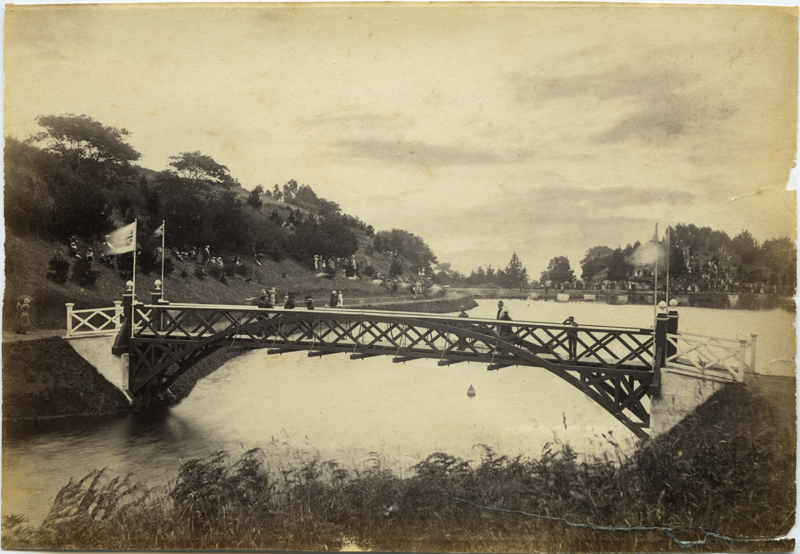
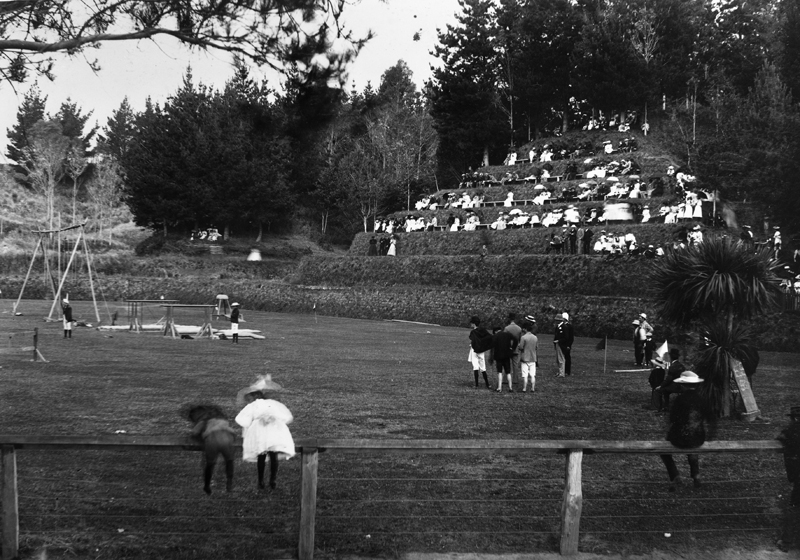
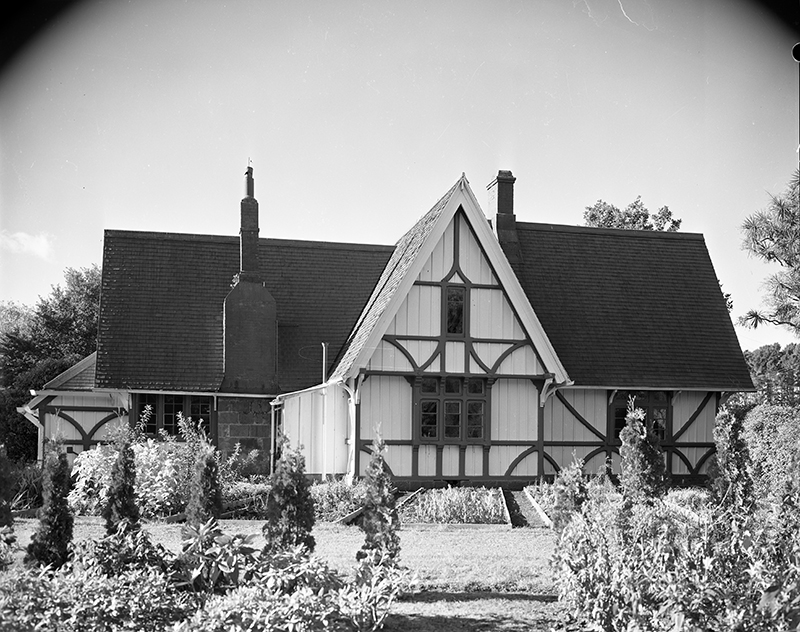
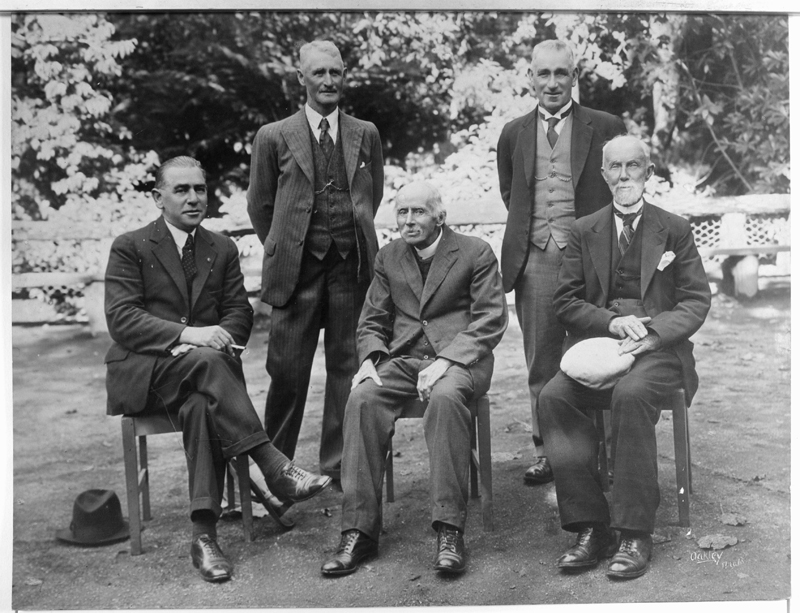
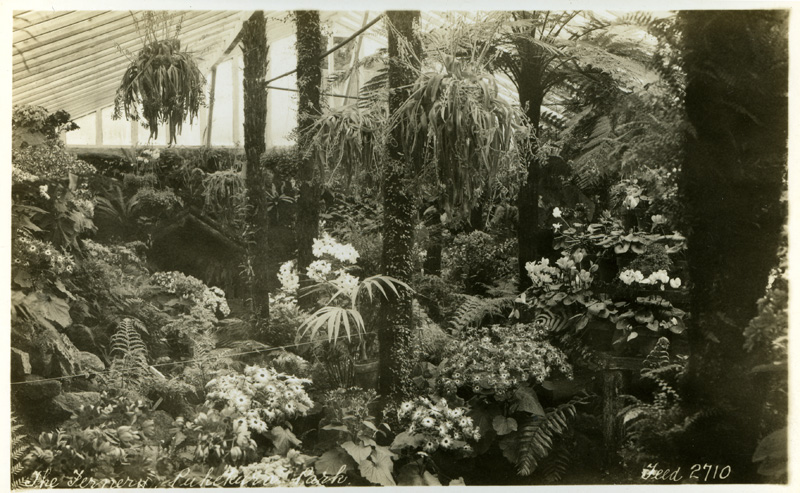
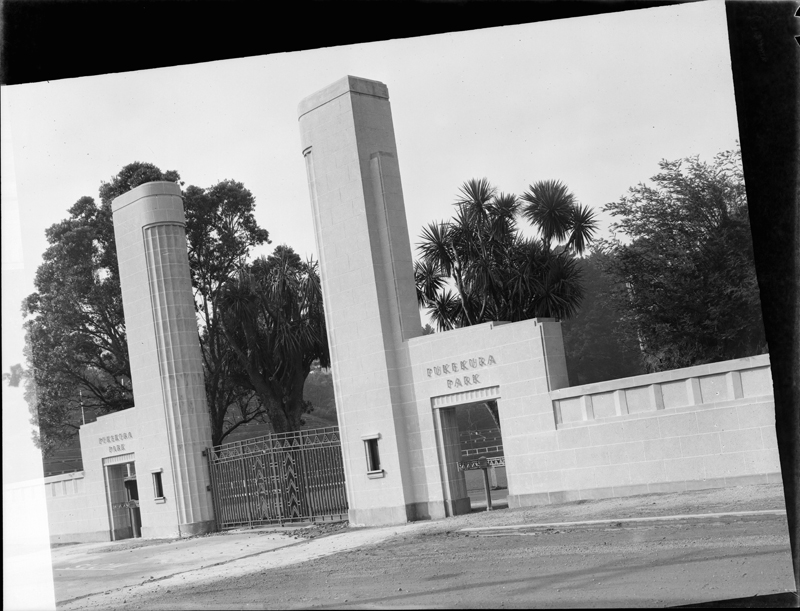
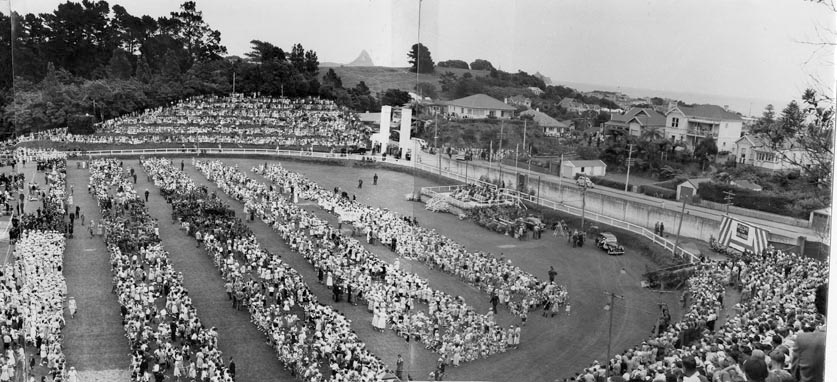
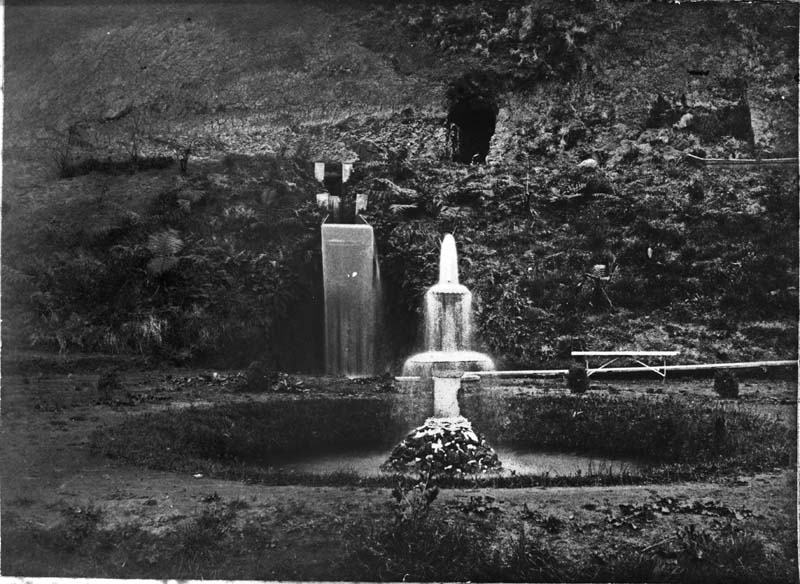
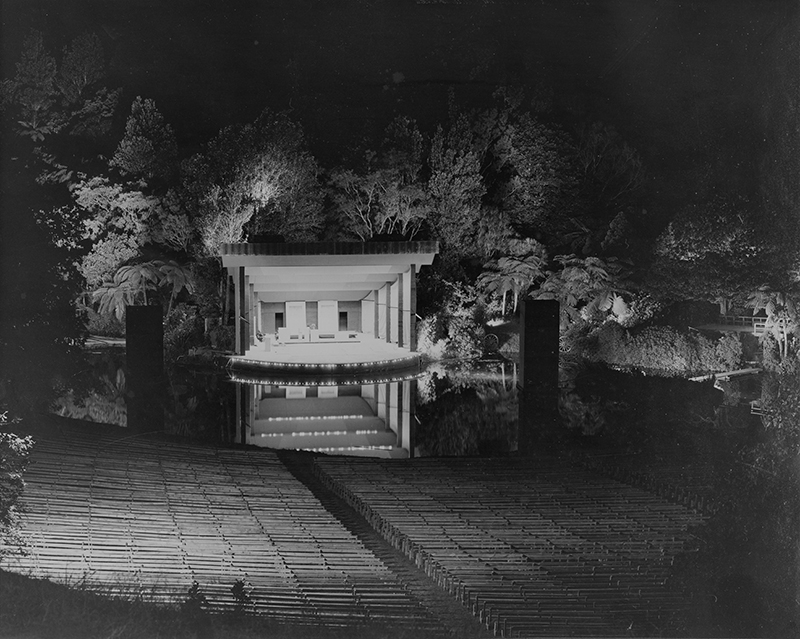
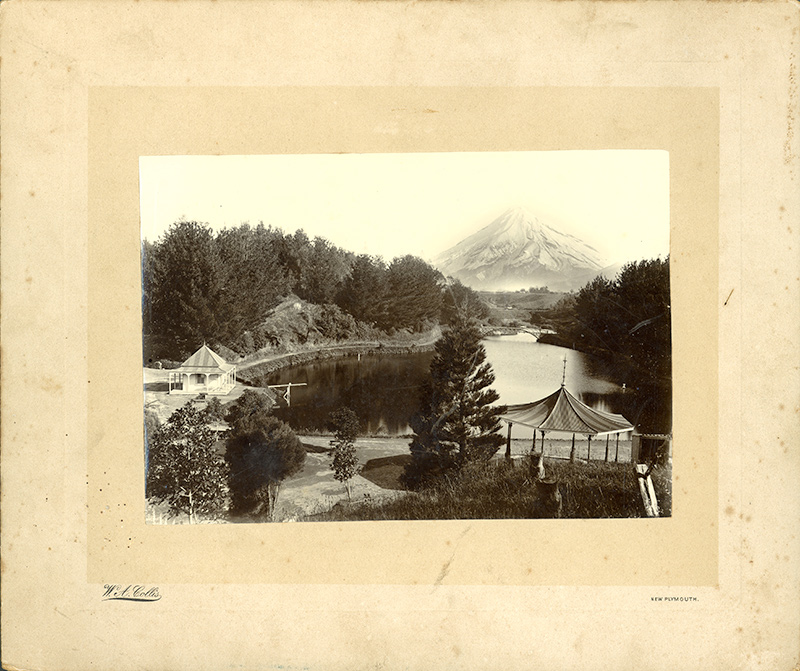
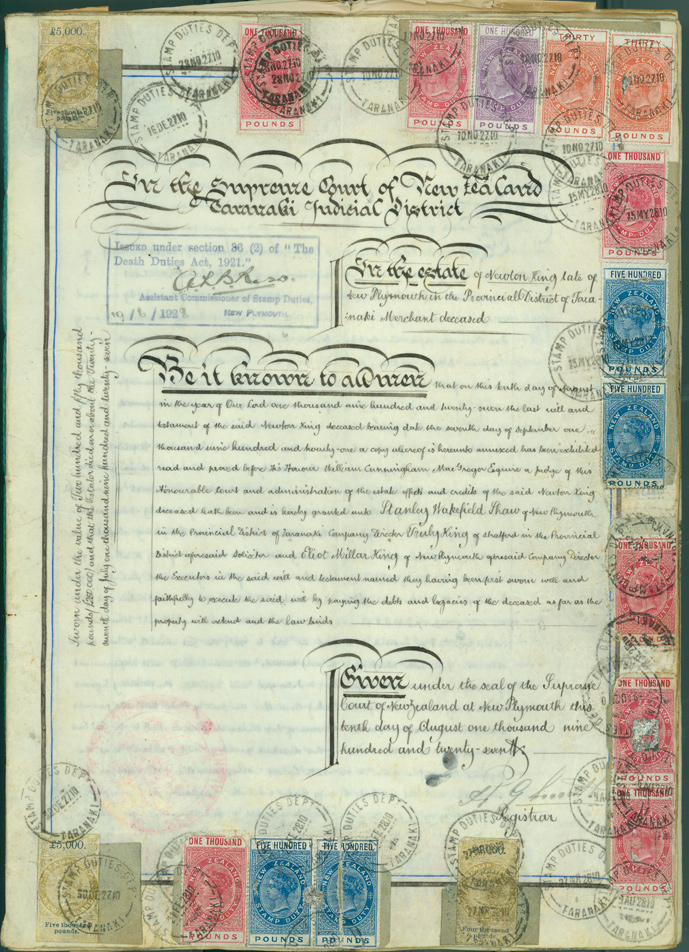
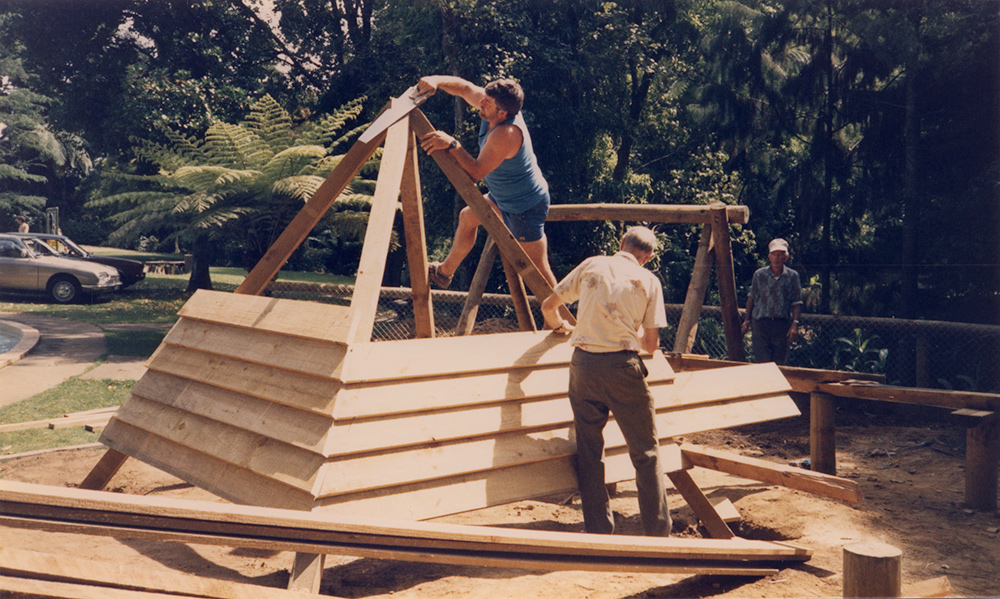

New Plymouth has a park for a heart. One that has thump-thumped with axes and spades and the clapping of wild crowds. It has quivered to the beat of world music, Split Enz and rock stars.
The lakes have pulsed with dancing water lights and rippled to the slow rhythm of rowboats. There have been drum rolls for a Queen and her mother and brass bands banging out Christmas carols. The winding trails have pounded with the sound of runners' feet and small children chasing among the trees.
Lovers' hearts have hammered during hand-in-hand strolls and, sadly, some hearts have been silenced. All this in Pukekura Park. A place that steals hearts.
Many people have tended this land, loved it with a passion born of fierce possession. John Claffey (1878-1896), William W. Smith (1908-1920), Thomas Horton (1924-1949), Iolanthe Small (1944-1992), John (Jack) Goodwin (1949-1977), Ailsa McCrone (1956-2001), George Fuller (1965-1990), Alan Jellyman (1962-2000) and Ian McDowell (1963-1999) are among those whose lives have been touched by its magic.
Many of these people will help tell the story of Pukekura Park, a garden made from the rough by spade-tough palms. But the first hands were soft and tender.
On 29 May 1876, Miss Jane Carrington planted the first four trees around the base of Cannon Hill. There was a pūriri for New Zealand, a Norfolk Pine for the South Pacific Islands, an oak for England and a Pinus radiata for the United States of America.
The shovel used by Miss Carrington, the daughter of Plymouth Company chief surveyor Frederic Alonzo Carrington, is in Puke Ariki's Social History collection. While the spade remains, the trees have gone.
For years, an understudy rooted just above the Hatchery Lawn has been hailed as the Carrington pine. But the true specimen disappeared sometime in the middle of last century.
Former park curator George Fuller has uncovered the mystery - with photographic proof. He has a black-and-white picture of the original Carrington pine planted on the northern side of the hill. Behind the bedraggled, headless pine is the sportsground and Fillis Street, while the foreground shows a sign declaring the tree's ceremonial roots. "That tree no longer exists," says George. Neither does the sign. "That sign was pretty shonky in 1934," he says, explaining how the park suffered a decade or more of neglect. "We know of the problems that existed in the '30s with the Depression and then the war years and lack of staff.
"Sometime late in the 1930s or early '40s, the identity of that tree in the photographs was lost."
Later, when the park was cleaned up, the unlabelled, scruffy pine was culled. "The stump still exists there." George could show it to you, and also place you in the exact position where the 1934 photo was taken.
There is some consolation for those distraught to discover they have been admiring an imposter for more than 50 years. "There's little doubt it [the surviving pine] was planted on the same day," George says.
While the young Miss Carrington planted the original four trees, it was energetic solicitor Robert Clinton Hughes who did the spadework to get New Plymouth its central park. By the 1870s, the town was developing rapidly and Hughes, a keen sportsman and swimmer, saw the urgent need for a recreation ground.
In 1874, as a member of the Taranaki Provincial Council, the young man began to push for land to be set aside. Hughes and provincial secretary Thomas Kelly saw the potential answer to their needs in a long gash of inhospitable, water-logged land, described at the time as “a number of hilly town sections and unmade streets intersected by gullies and streams and covered with fern, furze (gorse) and tutu (a poisonous native shrub)”.
Kelly warned that the council might be swayed by fears of timid ratepayers, so Hughes took matters into his own hands. On the morning of 30 June 1875, he headed for the council, stopping on the way to gather support. By the time he had reached the offices, he had persuaded six citizens to act with him as trustees for a park, thus avoiding the need of rates.
The men who agreed were: Isaac Broad, John Gilmour, Harris Ford, James Thomas Davis, Thomas King (Newton's father) and Augustus Weyergang (later replaced by Robert Collins). That same day, the provincial council passed an act to establish the 35 acre (15 hectare) section as a recreation area. This was to be the council's last legislative act, as it disbanded the following year. On 18 September 1876, the Colonial Government validated the council's final move.
These far-sighted settlers were trailblazers who recognised the importance of recreational space and a green belt in the middle of a growing settlement. Somehow, they imagined what could be.
George Fuller says the park is not entirely a natural wonder, but a garden planned, planted, designed and dug by human hands. "It was a treeless valley, described as derelict. The native trees had long since been cleared away," he says.
So, volunteer workers, both Māori and Pākehā, stacked up a staggering number of hours to form the park. Photographs of the day show the two cultures toiling side by side to create what many visitors declare “the most beautiful park in New Zealand, if not the world”.
One of the first things these volunteers did was harness the Pukekura Stream to make the main lake in 1878. To do this, a large clay dam was constructed beside Cannon Hill. Great care was taken as the board envisaged disastrous results if the earthworks collapsed and released a wall of water upon New Plymouth.
Extra support was gouged from the central hill. The southern slopes of the hill used to flow down to the edge of the pond, but a huge wedge was sliced off to form a flat space for the band stand, built in 1887. The resulting lake, filled in 1878, was an inviting stretch of water that led to swimming races, the addition of a springboard, building of a bathing shed in 1879 - and a segregation of the sexes. In 1886, the Pukekura Park Board decided that ladies and girls should bathe only between 8am and 1pm. Men and boys could bathe at other times.
So modest were the people of this Victorian era, that it was suggested gentlemen should not be permitted to enter the park during the ladies' hours. A compromise was reached, so that a red flag was hoisted in the grounds during the ladies' sessions and gentlemen were expected to be gentlemen and keep away.
The bathing days gradually faded until, in 1959, the New Plymouth Borough Council passed a bylaw banning bathing or wading in park lakes or waterways. The old bathing shed was pulled down in March 1969.
Other sporting codes have made their home at Pukekura Park, especially cricket. It all began with a swampy piece of land at the top of Liardet Street, which was drained and filled to become terra firma. The sportsground has seen so much life it has become a tale in itself.
The park has benefited from other types of racing - namely its postcard-pretty bridge. The Poet's Bridge evokes thoughts of romantic trysts, languid lovers and passionate verses. The reality is more of a good Kiwi bloke's dream come true.
In 1883, Pukekura Park board member James Davis drew the horse, The Poet, in a sweepstake on an Auckland race. It won, and Davis collected £150, which he immediately handed to the board for building the bridge.
Designing the bridge became a contest as fierce as the race won by The Poet. This time, victory came to engineer H.V.D. Barclay, whose graceful design spanned the water for more than 50 years. It was replaced just before World War Two, following the same design, remaining red and still bearing the romantic name.
While all this sounds like a feel-good fairytale, it did not end happily ever after for gambling man Davis. In 1891, he disappeared from his home one night and was found drowned beneath the bridge. The park has seen other deaths.
On 11 April 1890, aged army pensioner Stephen Maloney was found murdered under a pine tree on the path leading from the Main Lake to Rogan St, now known as Horton Walk. Police investigations led to a man called Mahi Kai, who consistently pleaded not guilty. But Kai was convicted and sentenced to death. This was later commuted to life imprisonment and he was released on 5 December 1906.
Another death shattered the peace of the park for many years. Surf lifesaver Wendy Snowdon went jogging through the park on 21 November 1986. About 10am, she ran down a grass slope and into Brooklands Park. At a convergence of tracks, a man called Gary Lawrence McKinley slipped out of the bushes and smashed her on the head with a rock. McKinley carried her unconscious body to a more remote location on the track and raped her. He then strangled her and left her for dead. About 20 minutes later, a person walking a dog along the track found Wendy. The 23-year-old was still alive - just. Wendy was taken to Taranaki Base Hospital and placed in intensive care. She never regained consciousness and died on 7 December. McKinley was later convicted of her rape and murder.
Pukekura Park has seen the full circle of life.
On 25 February 1996, Andrew Langslow was born among agapanthus halfway between Poet's Bridge and the park's Kiosk. Sue Langslow and husband John were walking in the park, when the expectant mother went into full labour. "It was one contraction and wham," Sue told The Daily News.
As Sue lay among the shelter of foliage, John delivered their fourth son into the world. The healthy babe in the woods weighed in at 2.3kg (5lb1oz). "Before he could speak, Andrew was made an honorary life member of the Friends of the Park," says fellow honorary lifer, George Fuller.
Cricket pavilion namesake Brian Bellringer wasn't born in the park, but he has grown up in it. The backyard of the Bellringer homestead flows straight into Pukekura Park and it's difficult to discern the border between the two.
His grandfather, Charlie Bellringer, had the house built in 1914. "People said 'Charlie what are you going out of town for?' It's hard to believe now," Brian says of the Victoria Road property in central New Plymouth. "I have lived here all my life, apart from when I was at university," says Brian, who earned a Batchelor of Arts at Auckland University, with honours in political studies.
From his home view, the 66-year-old has watched the park flourish. "When I was a boy, you used to be able to see the grandstand at the racecourse." Now the horizon is just a thick line of bush. "That shows how much it's grown," says Brian, who spent 30 years on the local council. "When the stadium was built, you could see the hall." Now you can only see a sliver of silver through distant trees.
The massive growth highlights one of the most difficult aspects of grooming a park like Pukekura - culling trees. In the park's early days, pine trees were planted on the higher points of the park. In the early 1900s, when William W. Smith took control, he began cutting out scruffy specimens, replacing them with New Zealand native trees.
In Thomas Horton's reign, he pruned back further, replacing with deciduous exotics and natives, including kauri planted in regimental lines.
When John (Jack) Goodwin took over in 1949, he faced a huge task of opening up the over-grown park after World War Two. Massive macrocarpa were felled in the areas now known as the children's playground, Goodwin Dell and Ambush Gully. Even more pines were axed on the park's central ridges.
Retired parks director Alan Jellyman says Goodwin also followed the regime of replacing with native specimens. "The philosophy was that instead of planting more pines, we would introduce rimu, kauri and miro that would have a 400-year lifespan, rather than 100."
This culling and renewing cycle will go on forever. But every time a giant falls there is a rumble. In 2004, parks director Bryan Gould came under fire for felling a few trees in Kauri Grove. These trees were originally planted in 1935 by Thomas Horton, but were placed too close together. As the huge trunks have risen and widened, they have become over-crowded. So some have had to come out. But Bryan Gould had a giant on his side this time. Botanical guru David Bellamy visited the park in July and gave the axing his full support, explaining how those kauri left could now reach for the sky.
Alan Jellyman says New Plymouth folk are extremely protective of their park. "The park has a very special character and I think that's recognised by the whole community in that if we aim to do anything radical in it, the community comes down on you like a tonne of bricks and tells you to get off the grass."
Jack Goodwin had to face mass criticism in the 1950s. The outrageous culprit - the planned fountain for the bottom lake. "They were afraid it would spoil the park," Jack says. "…they wanted to put the fountain down by the beach." But Jack had the backing of the New Plymouth Borough Council's Pukekura Park committee, so the project went ahead.
The fountain was opened in 1955 to commemorate Queen Elizabeth II and the Duke of Edinburgh's visit to the park the year before. When the water finally gushed, the people did too. "There was 6000 there at the opening - it was just chock-a-block around the fountain lake. I was operating it manually, because the automatic controls weren't completely fixed," Jack says. "I kept the show going all right. They were really enraptured with it."
The fountain spot has another history. George Fuller says there used to be a tiny island there, which a former park curator used as a hatching ground in the early 1900s.
"W.W. Smith was an internationally recognised ornithologist and natural historian," George says. It is believed Smith was the last person to have seen the now-extinct huia, whose tail feathers were used by Māori chiefs as a symbol of their mana. That last sighting was recorded in 1907.
Smith was also famous for firsts. "As I understand it, he was the first person to raise kiwi in captivity. He was able to achieve isolation on an island in the middle of what is now the fountain lake," George says. "It was ground-breaking apparently in that nobody had understood the incubation of kiwi." George says the kiwi experiment was a success, but was not a long-running project.
Another haven for native species is still standing the test of time. Thomas Horton was at the helm when a decision was made to turn a gorse-tangled clay bank into the tunnels of the famous fernery. Designed by a Mrs H. Lovell from Hāwera, the fernery opened in 1928.
Another addition in his time was a declaration of long love. In 1931, the teahouse (now known as the Kiosk) was built from funds provided by New Plymouth Mayor Charles Burgess and his wife Mary as a celebration of their golden wedding.
Two other major happenings changed the face of the park and those behind it. In 1929, Pukekura Park was handed over to the New Plymouth Borough Council. So, after years of being run by a board of trustees, the park was finally in local body hands, with all the benefits that come from such management, certain financial backing and expertise. However, the park was still administered by a committee of citizens until the mid-1960s.
The other big event happened in 1934. That's when Brooklands was given to the people of New Plymouth by the trustees of Newton King's will. The former businessman had left money to the town, but when his estate was wound up it was discovered he did not have enough cash in the bank to cover his generous pledges. In lieu of the money, the trustees handed over Brooklands. At the same time, a three-hectare portion of newspaperman Thomas List's Maranui property was given to New Plymouth.
While Horton's years were fruitful, some of his time as head of the park was dogged by the Great Depression and the onset of World War Two. The latter left New Zealand with a huge shortage of fit male workers.
When Jack Goodwin took over the park in 1949, his brief was to bring the people back to the park. And he did, by cutting back overgrown foliage to open up the paths and gardens. He also added attractions, including the fountain, the children's playground, Brooklands Zoo and filling in the hatchery pond to make a lawn. Together with George Fuller and Ian McDowell, Jack put in the illuminated waterfall and centennial waterwheel. The Bowl of Brooklands stage was also formed during Jack's years.
Alan Jellyman's greatest input was updating the fernery. "That conservatory always was, and still is today, the best public display conservatory anywhere in New Zealand and it would stand up to major ones overseas."
Adding music and entertainment to the annual Festival of the Lights event was another of Alan's innovations. "I had seen an example of a Melbourne parks programme, where they provided free entertainment in parks."
With the onset of daylight saving, there was a two-hour gap, from 6-8pm that needed to be filled and so Alan invited community groups to show their flair and wares. "Now it's extended to being a very comprehensive programme."
In March 2003, Brooklands Park and the Bowl first hosted the World of Music and Dance (WOMAD) festival.
Jack Goodwin's brief is still being fulfilled. Pukekura Park is a place for all people.
Scanlan, A.B. (1978). Pukekura: A centennial history of Pukekura Park and Brooklands. New Plymouth: New Plymouth City Council.
Pukekura Park Board (1929). History of Pukekura Park and the ceremony of vesting in New Plymouth Borough Council, Thursday 17th October, 1929. New Plymouth: Pukekura Park Board.
Quinn, P. (1999). Pukekura and Brooklands: a park for all people. Thames: Quintessential
Please do not reproduce these images without permission from Puke Ariki.
Contact us for more information or you can order images online here.